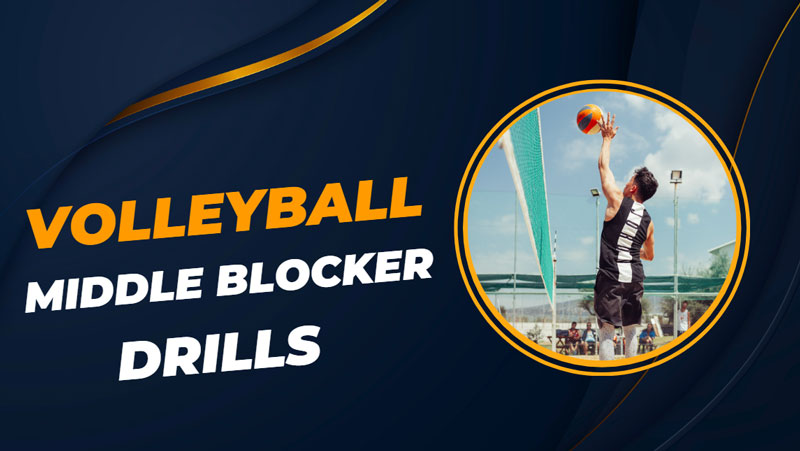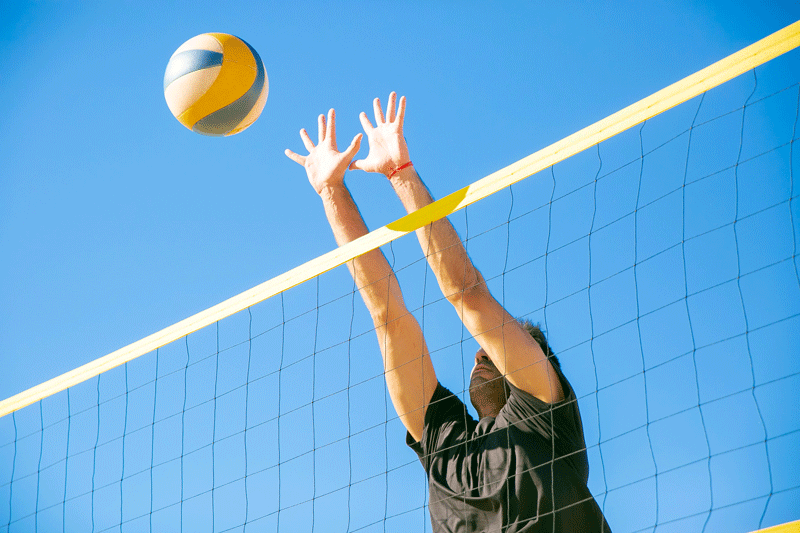4 Elementary Yet Efficient Volleyball Middle Blocker Drills
Crucial for victory, your capacity to effectively block opponents’ attacks and contribute to your team’s scoring defines your role as a Volleyball Middle Blocker drills.
In my perspective, the simplest volleyball drills often prove to be the most effective.
Assembled today is a compilation of the top 4 training drills for middle blockers that, in my opinion, encompass the only essential drills required to attain the status of an elite middle blocker.

Designed to assist you in excelling in your role, a set of targeted and efficient drills has been created. These drills are customized to enhance your agility, timing, footwork, and decision-making skills at the net.
Irrespective of whether you’re a newcomer to the position or aiming to enhance your existing skills, these drills will lay the groundwork for your progression as a middle blocker.
1. Footwork Drilling with an Unoccupied Net
Involving only you and the net, this drill focuses on refining your footwork and positioning skills.
Enhancing your footwork plays a crucial role in achieving success as a middle blocker in volleyball. The “Empty Net Footwork Drilling” places its emphasis on honing movement techniques, positioning, and agility.
According to my point of view, Irrespective of whether you’re a beginner or a seasoned player, these drills are crafted to enhance your effectiveness and versatility as a middle blocker.
Drill 1: Lateral Shuffle
- Initiate by assuming a poised position at the net.
- Engage in lateral shuffling along the net, all while upholding a low and well-balanced stance.
- Prioritize swift and precise movements.
- Execute 10 repetitions on both sides.
Drill 2: Quick Reaction Jumps
- Commence by positioning yourself at the net, ensuring your hands are prepared for blocking.
- React to a coach’s or partner’s cues to jump and touch the net with both hands.
- Give prominence to dynamic and forceful jumps, coupled with rapid reaction times.
- Conclude the drill by accomplishing 15 repetitions, varying the heights of your jumps.

Drill 3: Transition Moves
- Position yourself at the net in a stance akin to preparing for a block.
- Respond to cues promptly, swiftly adjusting your positioning to cover various sections of the net.
- Focus on seamless transitions from a blocking posture to defensive movements.
- Reiterate the sequence for 1 minute.
Drill 4: Mirror Movement
- Collaborate with a partner stationed on the opposing side of the net.
- One partner moves laterally along the net, while the other mirrors their movements on the opposite side.
- Prioritize synchronization and the preservation of a defensive posture.
- Exchange roles after completing 10 repetitions.
Focus on Agility, Quickness, and Precision Timing
Comprising a set of exercises, the “Empty Net Footwork Drilling” is designed to enhance your agility, quickness, and precision timing on the net.
With the ball tossed by the setter to the hitter, who subsequently launches an attack, the middle blocker engages in a focused practice involving intricate footwork and precise timing.
Requiring us to observe the set and react with utmost speed, as humanly possible.
I think focus on the correct placement of the feet, impeccable jump timing, and extending over the net for effective blocks.

Emphasize achieving seamless transitions
Achieving seamless transitions is a critical aspect of excelling as a volleyball middle-blocker drill.
Enabling you to be in the right position at the right time, this skill facilitates seamless and efficient shifts between various movements on the volleyball court.
Enhancing your effectiveness on the court, and the ability to swiftly transition from one action to another is crucial in the fast-paced environment of volleyball.
Built upon the foundation of solid footwork, achieving seamless transitions relies on the practice of swift movement and balance maintenance. The key footwork techniques, such as shuffling, cross-steps, and split steps, demand your focused attention.
Through consistent and dedicated practice of your footwork, along with honing your anticipation and transitional movements, you will witness the gradual transformation of seamless transitions into a natural and instinctive aspect of your performance during real matches.
2. Hitting Lines Delayed Blocking
`Certainly! In the drill focused on “Hitting Lines Delayed Blocking,” the effectiveness of timing and blocking heavily relies on the position and movement of the middle blocker.
Everyone is familiar with the basic ‘hitting lines’ drill, but in this simple modification, a middle blocker is introduced on the opposite side of the net, adding a new layer of complexity to the exercise.
When engaged in hitting line drills and facing hitters, the deliberate act of delaying your block becomes a crucial strategy. This deliberate delay serves to improve your capacity to decipher the hitter’s intentions and to time your jump with enhanced effectiveness.
- Bring together your teammates and arrange for a hitting line configuration on a single side of the net, ensuring there’s a coach or setter prepared to provide tosses to the hitters.
- Take your position at the net as a middle blocker, ready for a block. Maintain a balanced stance with your hands up.
- While the hitter gears up for their attack, purposefully pause your initial movement. This deliberate delay serves as a tactic to enable you to carefully observe the hitter’s actions and foresee their shot.
- After comprehending the hitter’s intentions and timing, execute a forceful jump to intercept the attack. Concentrate on extending your reach beyond the net and intruding into the hitter’s hitting zone.
- By facilitating the improvement of your block timing, this drill contributes to the development of a heightened sense achieved through observing the hitter’s actions before initiating a jump.
In my point of view, bear in mind that consistent practice of the “Hitting Lines Delayed Blocking” drill will play a role in fostering your advancement as a middle blocker, consequently influencing your overall impact on the game.
3. Basic Quick Hitting Line: Volleyball Middle Blocker Drills
In the realm of volleyball training, the utilization of the “Basic Quick Hitting Line” drill takes on the role of a foundational practice method. Its purpose lies in the enhancement of proficiency concerning quick attacks and seamless transitions that occur between the hitters and setters during gameplay.
- Assembling your team on a single side of the net, arrange for the setter to be stationed in proximity to the net while holding a ball. Simultaneously, align the hitters in a queue behind the setter for the subsequent actions.
- For the execution of this drill, assign specific roles by designating an individual as the setter and identifying multiple hitters who will actively participate.
- Positioned at the net and holding the ball, the setter assumes a stance. As the drill commences, the initial hitter in the lineup readies themselves to initiate an approach for a swift attack.
- Performing a swift approach that is precisely synchronized with the setter’s ball release, the hitter maintains impeccable timing during this phase of the drill.
- With precision, the setter administers a rapid and precise set to the hitter in motion. The intention is to target a strategic position that optimally facilitates a potent attack, elevating the effectiveness of the play.
- With a leap into action, the hitter swiftly launches into an attack that clears the net, precisely directing the shot toward a predetermined area on the opponent’s court. This deliberate targeting adds an element of strategic finesse to the offensive maneuver.
- After executing the attack, the hitter promptly shifts to the rear of the line. This movement facilitates the seamless transition for the next hitter in line, who proceeds to replicate the sequence.
Constituting a pivotal element within volleyball training, the Basic Quick Hitting Line drill assumes significance as it centers on the refinement of swift attack capabilities, precise timing, and the collaborative dynamics of teamwork.

4. Assisted Random Quick Hitting Line
Emerging as a unique drill, the Assisted Random Quick Hitting Line is intentionally crafted to elevate agility, adaptability, and collaborative synergy among players when engaged in swift attacks.
With its primary goal firmly established, the Assisted Random Quick Hitting Line drill centers on elevating players’ adeptness in rapidly adjusting to diverse sets provided by different setters. This proficiency ultimately empowers swift and decisive actions during quick attacks.
- Gather your team members on a single side of the net, ensuring the readiness of numerous setters and hitters who are prepared to actively engage in the drill.
- Once the hitter is chosen, the setter delivers a quick set to the selected hitter. The hitter executes a quick attack over the net.
- Upon the completion of the attack, the hitter efficiently transitions to the rear of the line, allowing the subsequent hitter to take their position and participate in the drill.
Through its structured practice, the drill equips players with the readiness to effectively react to diverse settings and attackers, thereby nurturing a heightened versatility in formulating offensive strategies.
When executed with precision, this drill serves as a near-perfect simulation of over 90% of middle-blocker offenses, providing invaluable insights and practical experience in a controlled practice environment.
Also Read: How Tall Are Middle Blockers In Volleyball? [Guide 2024]
